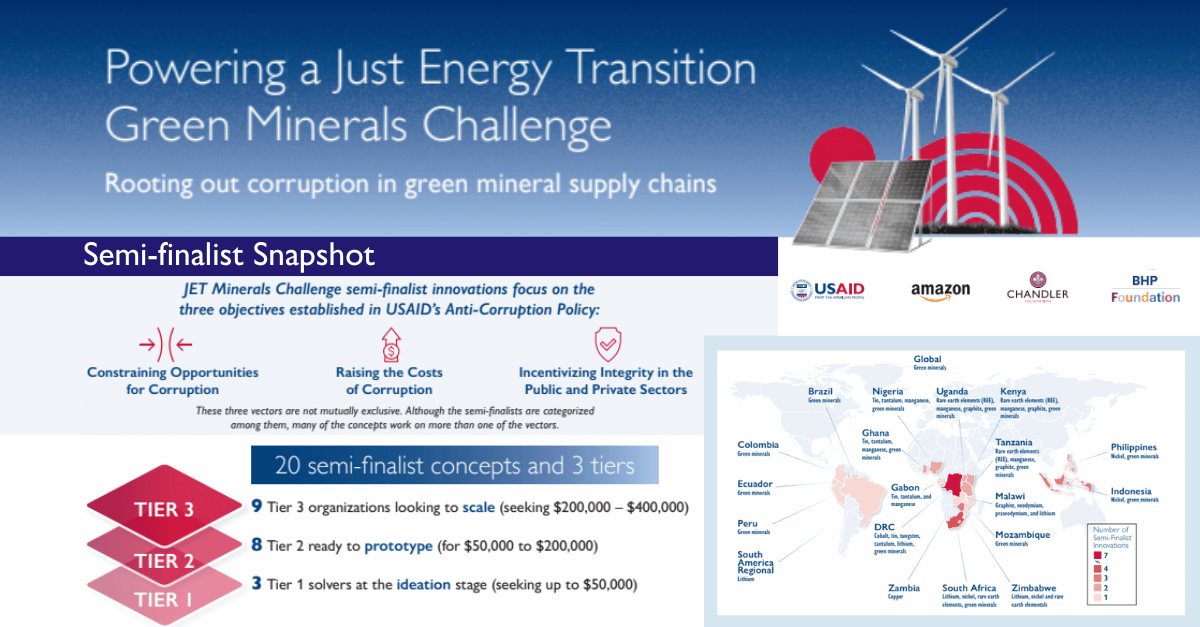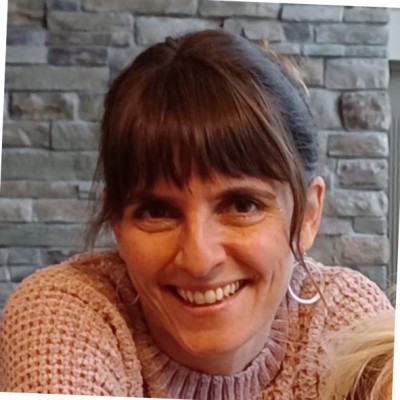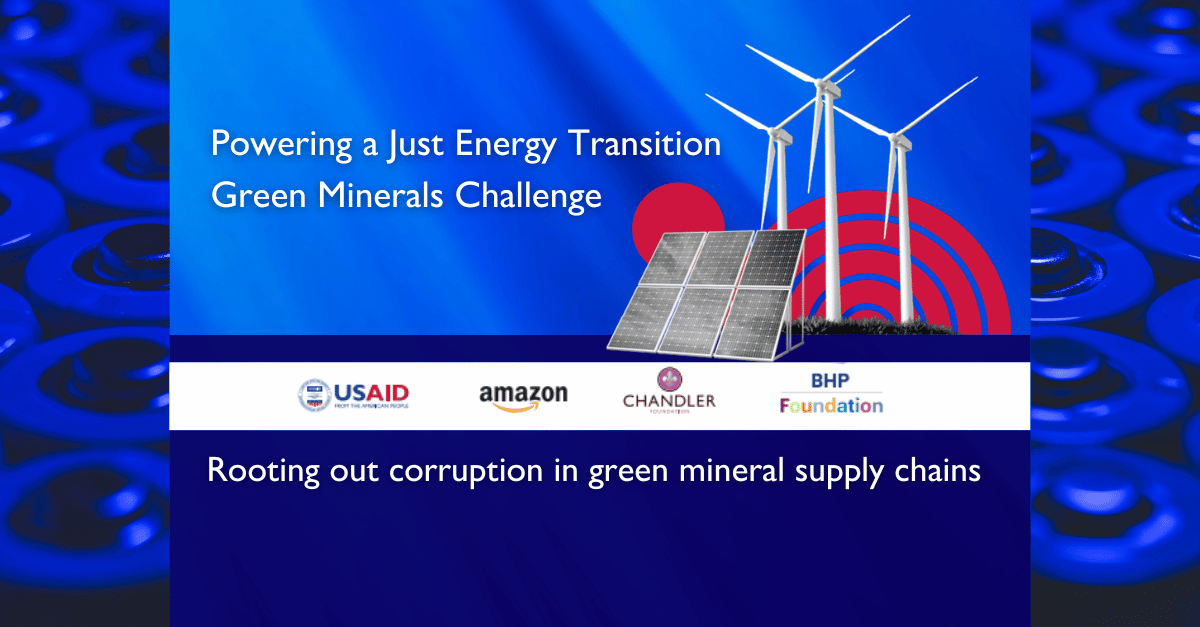A few months ago, we featured in our published Insights a backgrounder on the role of green mining for a low-carbon, sustainable future, which provided context for the recently announced Just Energy Transition (JET) Minerals Challenge. This is the first activity under the USAID-supported Countering Transnational Corruption Grand Challenge for Development (CTC Grand Challenge), a partnership initiative that also includes Amazon, the BHP Foundation, and the Chandler Foundation.
We continue to follow the journey of this challenge and the changemakers and innovators involved, including here the announced semi-finalists who will advance to the next phase of this process.
What is the JET Minerals Challenge?
The JET Minerals Challenge catalyzes the development, application, and scaling of innovations to counter corruption and strengthen transparency, accountability, and integrity in the global rush to meet the unprecedented demand for green minerals. This open call for innovation welcomed concepts from all sectors and geographies to submit both new ideas and proven approaches to reduce corruption in green mineral supply chains.
The response was very positive. Nearly 60 concepts drawing from expertise around the world were submitted, and a rigorous selection panel composed of industry experts announced at a side event of the second Summit for Democracy the 20 semi-finalists now eligible to advance to the next stage of the JET Minerals Challenge.
A Snapshot of the Semi-Finalists
The selected concepts represent significant diversity, geographically, sectorally, and in terms of the type of organization - including thirteen women-led lead organizations. More than half of the innovative concepts propose global or regional initiatives to address transnational corruption, while 8 focus on a single country. Covering 18 unique geographies, some concepts address green mineral supply chains generally, whereas others target specific green minerals supply chains - ranging from lithium and tin, tungsten, and tantalum (known as the 3Ts) to manganese and rare earth elements.
This semi-finalist cohort consists of three Tier #1 solvers at the ideation stage (seeking up to $50,000), eight Tier #2 innovations ready to prototype (seeking $50,000 - $200,000), and nine Tier #3 innovations looking to scale (seeking $200,000 - $400,000). In total, the JET Minerals Challenge will provide successful grantees up to $400,000 in funding (with a total grant pool of $3,000,000) in addition to targeted acceleration support and technical assistance.
As the demand for green minerals spikes, this activity is vital to fulfilling the promise of an inclusive, sustainable, and just future for clean energy and avoiding the “resource curse” that has accompanied other extractives industries. To that end, the JET Minerals Challenge outlined three strategic objectives that guided submissions and will serve as the focus for semi-finalists as they move to the next stage:
- constraining opportunities for corruption
- raising the costs of corruption
- incentivizing integrity in the public and private sectors
 The announced winners of this important stage of the JET Minerals Challenge are listed below, by objective, and represent the depth and breadth of proposed challenges by stage:
The announced winners of this important stage of the JET Minerals Challenge are listed below, by objective, and represent the depth and breadth of proposed challenges by stage:
Constraining Opportunities for Corruption
- In the Philippines, Bantay Kita, Inc. proposes the Open and Green Mining Initiative to scale up the provision of tools and technical assistance to empower small mining communities, resulting in a more transparent, accountable, and well-governed mining industry.
- In the Democratic Republic of Congo (DRC), Ecuador, and the Philippines, Sustainable Development Strategies Group proposes a Community Development Agreement (CDA) Digital Innovation Hub to facilitate public access to CDAs, increase transparency, and over time, enable communities and companies to ensure equitable management of mining impacts and benefits.
Raising the Costs of Corruption
- In the DRC, Kenya, Tanzania, and Uganda, BASIS International Limited proposes scaling an existing digital integrated anti-corruption whistleblowing platform to the Great Lakes Region. The platform will be tailored to combat corruption in the minerals supply chain.
- In the DRC, Ghana, Nigeria, and Mozambique, the Centre for Journalism Innovation and Development proposes combining data aggregation tools; media and civic engagement; and capacity building for journalists, civil society, and anti-corruption practitioners on the use of data to enable transparency and accountability in the green minerals sector.
- In Malawi, Perekezi ASM Consultants proposes mobilizing civil society organizations, media, elected government officials, traditional leaders, and government officials to oversee licensing, contracting, mining, and trading in the mining sector.
- Globally, Ethic Alliance, Inc. proposes scaling its established process combining an online reporting platform, global and local partnerships, public education, information sharing and public-private partnerships to raise the costs of corruption.
- In South Africa, Global Financial Integrity proposes implementing its risk assessment tool for trade invoicing in the South African Revenue Service, Central Bank, and Financial Intelligence Unit to reduce corruption and illicit flows and increase correct invoicing at customs.
- Globally, the Initiative for Responsible Mining Assurance (IRMA) proposes developing and piloting resources to directly engage affected communities, non-governmental organizations (NGOs), and workers, enabling them to understand the value of and prepare to contribute to an independent third-party audit, conduct their own assessments of a mine or mineral processing site, and use audit reports to protect their rights.
- In South Africa and Zimbabwe, Green Governance Zimbabwe and its partner proposes capacity strengthening activities like training and whistleblower protection for youth in mining communities, enabling them to engage duty bearers and mining companies to promote sustainable and mutually rewarding benefits from mining projects.
- In Brazil, Indonesia, and South Africa, the Global Initiative against Transnational Organized Crime proposes conducting an organized crime threat assessment of the green minerals sector, developing a tool that trains other stakeholders to conduct similar assessments, and providing training on utilizing the assessment and implementing appropriate responses.
- In the DRC, Resource Matters proposes providing documentation on emblematic cases of corruption to support sanction authorities’ efforts in fighting transnational corruption in mining, particularly in the cobalt and lithium sectors.
Incentivizing Integrity
- In the DRC, IMPACT and its partners propose a three-part solution to increase transparency and monitoring among cobalt supply chain actors and state agents, including mapping and publishing all legally required payments, developing an anti-corruption index, and a digital tool to motivate upstream supply chain actors.
- In the DRC, The Impact Facility and its partner proposes reducing corruption in the cobalt mining and trading industry by developing and deploying incentives for the adoption of digital payment systems to bring more transparency to trade and establish a technical barrier to corrupt and fraudulent behavior.
- In Indonesia, Zambia, and Zimbabwe, Transparency International Australia and its partners propose refining and implementing its existing, online Responsible Mining Business Integrity tool, which offers companies involved in green minerals extraction a flexible, effective, and systematic approach to understanding corruption risks in their operations.
- In Kenya, Tanzania, and Uganda, Adaptive Resources LLC and its partners propose disrupting corruption through their Adaptive Application's integrative set of services, including tailored Know Your Customer and Anti-Money Laundering tools, where users can assess, screen, and manage risks related to good governance and corruption in mineral supply chains.
- The Center for International Private Enterprise (CIPE) proposes establishing a Green Mining Transparency Scorecard to celebrate good governance and monitor and rank the transparency and accountability of different actors in the mining sector, incentivizing integrity and encouraging long-term, inclusive economic growth.
- In Gabon, Ghana, and Nigeria, MINEXX LTD and its partners propose a digital platform to facilitate access to financing and international markets for miners and traceability services for buyers. The platform partners with governments and private entities to spearhead the adoption of transparent systems in the mining supply chain.
- In Tanzania, Phimona Limited proposes scaling the Temisite application, an online platform connecting suppliers with buyers that aims to improve transparency and efficiency of the mineral supply chain, reducing corruption and poor governance.
- In the DRC, Datastake OU proposes to continue implementing an interactive database platform that classifies supply chain information and incentivizes information sharing to stimulate transparency, generate accountability, and constrain corruption opportunities.
- Talisman International proposes developing a dashboard collating publicly available but hard-to-find data on patterns of corruption relating to lithium extraction in South American source countries to inform the due diligence activities of companies procuring lithium for green technology.
What Role do Grand Challenges Play in Driving Innovative Solutions to Complex Problems?
Grand Challenges leverage the knowledge and expertise of diverse stakeholders, including the private sector and local actors, to support collective problem solving and identification of new solutions. By mobilizing their convening power and networks, Grand Challenge partners draw global attention to a development problem and bring new voices to the table – building a coalition that is diverse, powerful, and agile.
To date, across eleven past Grand Challenges, USAID and its partners have committed more than $500 million in grants and technical assistance and catalyzed an additional $900 million in external follow-on funding, providing innovators with the expertise, resources, and networks that they need to grow.
What are the Next Steps in the JET Minerals Challenge Journey?
Although there will ultimately be finalists selected from among these 20 changemakers and innovators, the JET Minerals Challenge is committed to providing semi-finalists with valuable assistance and advisement in the preparation of the next stage that will prove invaluable to their organizations and missions well beyond the scope and duration of this initiative.
Semi-finalists will join an in-person two-day innovation bootcamp, hosted alongside the OECD Forum on Responsible Mineral Supply Chains in April 2023.
Resonance will continue to report on the JET Minerals Challenge and the journey of participants through finalists and grantees. You can also follow their journey and receive updates on the successful finalists on the USAID website or by joining our CTC Grand Challenge network by emailing challengecorruption@usaid.gov.
NOTE: Images used in this Insights on the JET Minerals Challenge are included in the “Powering a Just Energy Transition Green Minerals Challenge” Fact Sheet published by USAID.


